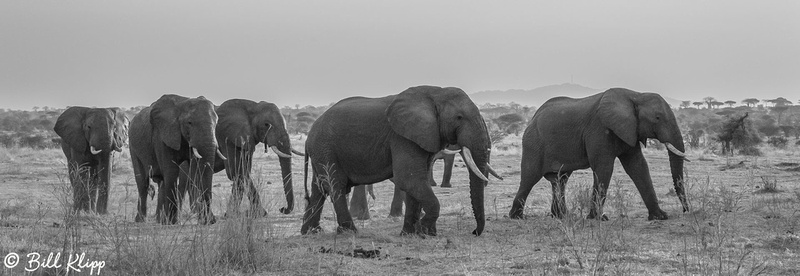 Great Egrets, Discovery Bay Photos by Bill KlippGreat Egrets, Discovery Bay Photos by Bill Klipp
Great Egrets, Discovery Bay Photos by Bill KlippGreat Egrets, Discovery Bay Photos by Bill Klipp
All photos © Bill Klipp, not for Commercial Use of any type, for personal use only.
After a winter of out of town travel we returned mid-May to some gorgeous Delta Spring weather. Our first few days back on the water were amazing, virtually no other boats on the water and creatures of all sorts doing what they do undisturbed by the dozens of boats that will soon be filling our sloughs. The rains have stopped, the days have started to warm up while the evenings continue to cool down. I always wonder what I will find when uncovering the boat after 6 months of hibernation and to my joyful surprise the boat was relatively clean and more importantly the engine started right up after a short turn of the key. So for the next few nights we ventured out on our usual “Sunset Wine Cruise Safari” in search of the many creatures who call the Delta home, we of course were armed with some chilled sauvignon blanc and light snacks. With a full moon only a few days away we had some extraordinary low tides right around sunset, perfect timing as the exposed mud flats are a magnet to all sorts of creatures wandering about in search of a meal. All photos taken over the last week.
(A periodic photo blog of our Discovery Bay and Delta Wanderings)
 Discovery Bay Photos by Bill KlippDiscovery Bay Photos by Bill Klipp
Discovery Bay Photos by Bill KlippDiscovery Bay Photos by Bill Klipp
All photos © Bill Klipp, not for Commercial Use of any type, for personal use only.
 Lighthouse, Discovery Bay Photos by Bill KlippLighthouse, Discovery Bay Photos by Bill Klipp
Lighthouse, Discovery Bay Photos by Bill KlippLighthouse, Discovery Bay Photos by Bill Klipp
All photos © Bill Klipp, not for Commercial Use of any type, for personal use only.
 Great Blue Heron, Discovery Bay Photos by Bill KlippGreat Blue Heron, Discovery Bay Photos by Bill Klipp
Great Blue Heron, Discovery Bay Photos by Bill KlippGreat Blue Heron, Discovery Bay Photos by Bill Klipp
All photos © Bill Klipp, not for Commercial Use of any type, for personal use only.
Great Blue Herons
At 4 feet tall these magnificent wading birds are able hunters often seen patiently stalking their prey consisting of fish, frogs, crustaceans, lizards, ducklings, goslings and even small ground hogs. They will often stab their prey with a lightening like strike with their long sharp bill.
 Great Blue Heron, Discovery Bay Photos by Bill KlippGreat Blue Heron, Discovery Bay Photos by Bill Klipp
Great Blue Heron, Discovery Bay Photos by Bill KlippGreat Blue Heron, Discovery Bay Photos by Bill Klipp
All photos © Bill Klipp, not for Commercial Use of any type, for personal use only.
 Great Blue Heron, Discovery Bay Photos by Bill KlippGreat Blue Heron, Discovery Bay Photos by Bill Klipp
Great Blue Heron, Discovery Bay Photos by Bill KlippGreat Blue Heron, Discovery Bay Photos by Bill Klipp
All photos © Bill Klipp, not for Commercial Use of any type, for personal use only.
Great Blue Heron with a large catfish, notice how he stabbed the fish with his long sharp bill. Turned out the fish was a bit too big to swallow, so the Heron let it go and went on to find a smaller delicacy, a crayfish
 Great Blue Heron, Discovery Bay Photos by Bill KlippGreat Blue Heron, Discovery Bay Photos by Bill Klipp
Great Blue Heron, Discovery Bay Photos by Bill KlippGreat Blue Heron, Discovery Bay Photos by Bill Klipp
All photos © Bill Klipp, not for Commercial Use of any type, for personal use only.
Great Blue Heron with a Crayfish.
 Great Blue Heron, Discovery Bay Photos by Bill KlippGreat Blue Heron, Discovery Bay Photos by Bill Klipp
Great Blue Heron, Discovery Bay Photos by Bill KlippGreat Blue Heron, Discovery Bay Photos by Bill Klipp
All photos © Bill Klipp, not for Commercial Use of any type, for personal use only.
Great Blue Heron taking flight
 Snowy Egret, Discovery Bay Photos by Bill KlippSnowy Egret, Discovery Bay Photos by Bill Klipp
Snowy Egret, Discovery Bay Photos by Bill KlippSnowy Egret, Discovery Bay Photos by Bill Klipp
All photos © Bill Klipp, not for Commercial Use of any type, for personal use only.
Snowy Egret on the prowl for a meal.
It's easy to distinguish the Snowy Egret from their larger cousin, the Great Egret. Snowy Egrets are smaller, have a dark bill, black legs and yellow feet. While the larger Great Egret has a yellow bill with black legs and feet. They are both wading birds which seek their main prey of fish and crustaceans by wading in shallow water or hunting from docks, branches or other objects that over hang the water. These guys are often most active during low tides which exposes all sorts of small yummy creatures.
 Great Egrets, Discovery Bay Photos by Bill KlippGreat Egrets, Discovery Bay Photos by Bill Klipp
Great Egrets, Discovery Bay Photos by Bill KlippGreat Egrets, Discovery Bay Photos by Bill Klipp
All photos © Bill Klipp, not for Commercial Use of any type, for personal use only.
Great Egret with a Crayfish
 Great Egrets, Discovery Bay Photos by Bill KlippGreat Egrets, Discovery Bay Photos by Bill Klipp
Great Egrets, Discovery Bay Photos by Bill KlippGreat Egrets, Discovery Bay Photos by Bill Klipp
All photos © Bill Klipp, not for Commercial Use of any type, for personal use only.
Great Egrets
 Great Egrets, Discovery Bay Photos by Bill KlippGreat Egrets, Discovery Bay Photos by Bill Klipp
Great Egrets, Discovery Bay Photos by Bill KlippGreat Egrets, Discovery Bay Photos by Bill Klipp
All photos © Bill Klipp, not for Commercial Use of any type, for personal use only.
In spite of many yards of empty shoreline these Great Egrets sometimes fight over a perceived good hunting spot.
It's not all about the birds as we have several species of aquatic mammals in the Delta. We have Muskrats, Beavers and River Otters often all living harmoniously in the same ecosystem.
 Muskrat, Discovery Bay Photos by Bill KlippMuskrat, Discovery Bay Photos by Bill Klipp
Muskrat, Discovery Bay Photos by Bill KlippMuskrat, Discovery Bay Photos by Bill Klipp
All photos © Bill Klipp, not for Commercial Use of any type, for personal use only.
Muskrats are the smallest of our three semi-aquatic mammals. Their name comes from the "musky" odor they mark their territory with. These members of the rodent family have a round head and body, with a long roundish (or more accurately vertically flat, opposite of the flat tailed Beaver) hairless tail covered in scales. While their rear feet are semi-webbed they mostly use their tails for propulsion in the water. On land they drag their tails making their tracks easy to identify. Muskrats normally live in groups consisting of a male and female pair and their young. In our area they live in burrows dug into the mud banks usually with an underwater entrance, although at low tide their den entrances are often visible. Adults are 16-28 inches long and weigh 1-4 pounds.
 Muskrat, Discovery Bay Photos by Bill KlippMuskrat, Discovery Bay Photos by Bill Klipp
Muskrat, Discovery Bay Photos by Bill KlippMuskrat, Discovery Bay Photos by Bill Klipp
All photos © Bill Klipp, not for Commercial Use of any type, for personal use only.
This male Muskrat just emerged from his burrow. While they are omnivores they feed mostly on vegetation and are most active at night or near dawn and dusk.
 Muskrat, Discovery Bay Photos by Bill KlippMuskrat, Discovery Bay Photos by Bill Klipp
Muskrat, Discovery Bay Photos by Bill KlippMuskrat, Discovery Bay Photos by Bill Klipp
All photos © Bill Klipp, not for Commercial Use of any type, for personal use only.
"Muskrat Love"
Like most rodents, Muskrats are prolific breeders. Females can have two or three litters a year of six to eight young each.
 Muskrat, Discovery Bay Photos by Bill KlippMuskrat, Discovery Bay Photos by Bill Klipp
Muskrat, Discovery Bay Photos by Bill KlippMuskrat, Discovery Bay Photos by Bill Klipp
All photos © Bill Klipp, not for Commercial Use of any type, for personal use only.
Copulation can occur on land or in the water.
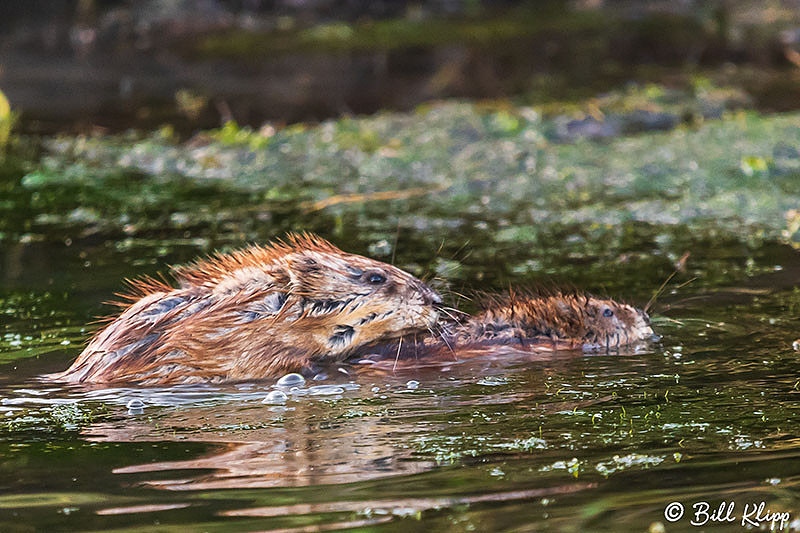 Muskrat, Discovery Bay Photos by Bill KlippMuskrat, Discovery Bay Photos by Bill Klipp
Muskrat, Discovery Bay Photos by Bill KlippMuskrat, Discovery Bay Photos by Bill Klipp
All photos © Bill Klipp, not for Commercial Use of any type, for personal use only.
 Muskrat, Discovery Bay Photos by Bill KlippMuskrat, Discovery Bay Photos by Bill Klipp
Muskrat, Discovery Bay Photos by Bill KlippMuskrat, Discovery Bay Photos by Bill Klipp
All photos © Bill Klipp, not for Commercial Use of any type, for personal use only.
After doing his business this guy was hoping for a cigarette.
 River Otter, Discovery Bay Photos by Bill KlippRiver Otter, Discovery Bay Photos by Bill Klipp
River Otter, Discovery Bay Photos by Bill KlippRiver Otter, Discovery Bay Photos by Bill Klipp
All photos © Bill Klipp, not for Commercial Use of any type, for personal use only.
Unlike the short compact body of the Muskrat our River Otters are truly aquatic creatures built for swimming with a narrow head and a long streamlined body, long whiskers, webbed feet and a long tail covered in fur. These guys are fast agile swimmers very comfortable in the water. They are 26-42 inches long and weigh in at 11-30 pounds with sharp predatory teeth feeding mostly on fish but with an active appetite for clams, mussels, frogs, lizards, snails, turtles and crayfish. They also make their homes in burrows in the mud banks. These guys often wander far from their burrows exploring the waters and often climbing on docks and boats.
 River Otter, Discovery Bay Photos by Bill KlippRiver Otter, Discovery Bay Photos by Bill Klipp
River Otter, Discovery Bay Photos by Bill KlippRiver Otter, Discovery Bay Photos by Bill Klipp
All photos © Bill Klipp, not for Commercial Use of any type, for personal use only.
This River Otter is munching on a Crayfish, trying not to get nipped by the Crayfish's claws.
 Beaver, Discovery Bay Photos by Bill KlippBeaver, Discovery Bay Photos by Bill Klipp
Beaver, Discovery Bay Photos by Bill KlippBeaver, Discovery Bay Photos by Bill Klipp
All photos © Bill Klipp, not for Commercial Use of any type, for personal use only.
A baby Beaver swims by. Found in nearly every state the Beaver is the largest North American rodent and the only one with a broad, flat, scaly tail. Weighing in at 30-60 pounds these guys are much bigger than our Muskrats and Otters. They are true herbivores and while best known for their small tree felling skills and building dams our Delta Beavers live in burrows in the shoreline banks and mostly munch on tule roots, hyacinth, cattails, and other marsh plants. When alarmed or annoyed they will loudly slap their big flat tail on the surface of the water as they dive down below.
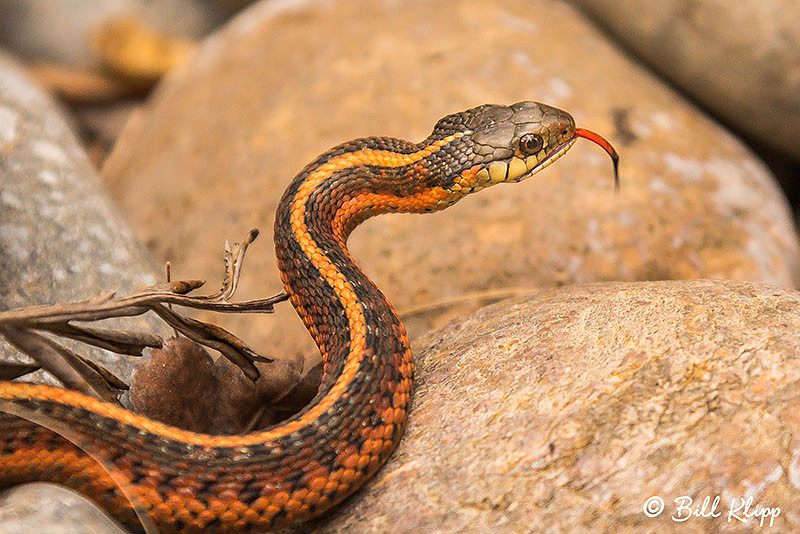 Garter Snake, Discovery Bay Photos by Bill KlippGarter Snake, Discovery Bay Photos by Bill Klipp
Garter Snake, Discovery Bay Photos by Bill KlippGarter Snake, Discovery Bay Photos by Bill Klipp
All photos © Bill Klipp, not for Commercial Use of any type, for personal use only.
Garter Snakes can often be found in the rocks along the levee or in your garden. Their diet consists of almost any small creature they are capable of overpowering including: worms, slugs, lizards, amphibians, minnows and small rodents. While some may find their presence alarming they are actually very good garden visitors.
 Garter Snake, Discovery Bay Photos by Bill KlippGarter Snake, Discovery Bay Photos by Bill Klipp
Garter Snake, Discovery Bay Photos by Bill KlippGarter Snake, Discovery Bay Photos by Bill Klipp
All photos © Bill Klipp, not for Commercial Use of any type, for personal use only.
While harmless these guys when threatened or picked up will discharge a malodorous, musky-scented secretion from a gland under their tail. They will often flatten their heads and strike out at any threats making them seem much more threatening then they are. They are easily pinned down with a stick and can be picked up by grabbing them right behind the head. They do have small teeth and their bite can be more alarming than hurtful as they have pretty small mouths.
 Dusky(?) Flycatcher, Discovery Bay Photos by Bill KlippDusky(?) Flycatcher, Discovery Bay Photos by Bill Klipp
Dusky(?) Flycatcher, Discovery Bay Photos by Bill KlippDusky(?) Flycatcher, Discovery Bay Photos by Bill Klipp
All photos © Bill Klipp, not for Commercial Use of any type, for personal use only.
Often found on branches overhanging the water Flycatchers can often be seen swooping down from a branch to catch a fly, moth or small flying insect. Flycatchers are part of a large family of birds with over 400 types.
 Barn Swallows, Discovery Bay Photos by Bill KlippBarn Swallows, Discovery Bay Photos by Bill Klipp
Barn Swallows, Discovery Bay Photos by Bill KlippBarn Swallows, Discovery Bay Photos by Bill Klipp
All photos © Bill Klipp, not for Commercial Use of any type, for personal use only.
Barn Swallows sometimes called Mud Swallows are very agile flyers often seen at dusk swooping over the water snagging little insects. They like living near water as they build their nests out of mud under building overhangs, under bridges and here in Discovery Bay often under dock ramps.
 Killdeer, Discovery Bay Photos by Bill KlippKilldeer, Discovery Bay Photos by Bill Klipp
Killdeer, Discovery Bay Photos by Bill KlippKilldeer, Discovery Bay Photos by Bill Klipp
All photos © Bill Klipp, not for Commercial Use of any type, for personal use only.
Killdeer while truly a shorebird can be seen without going to the beach, they are graceful plovers common to lawns, golf courses, athletic fields, and parking lots. In the Delta you will often see one or two scurrying back and forth along the shoreline most often at low tide.
 Green Heron, Discovery Bay Photos by Bill KlippGreen Heron, Discovery Bay Photos by Bill Klipp
Green Heron, Discovery Bay Photos by Bill KlippGreen Heron, Discovery Bay Photos by Bill Klipp
All photos © Bill Klipp, not for Commercial Use of any type, for personal use only.
The Green Heron can be found at the water’s edge often on the rocks or even on docks as they patiently crouch incredibly still waiting for an unsuspecting fish or small crustacean to swim by. Then with lightning speed they extend their necks really long to grab a meal with their dagger like bill. If you find the shells of Crayfish on your dock it was probably the leftovers from a Green Heron’s meal. The Green Heron is one of the world’s few tool-using bird species. It often creates fishing lures with bread crusts, insects, earthworms, twigs, feathers, and other objects, dropping them on the surface of the water to entice small fish
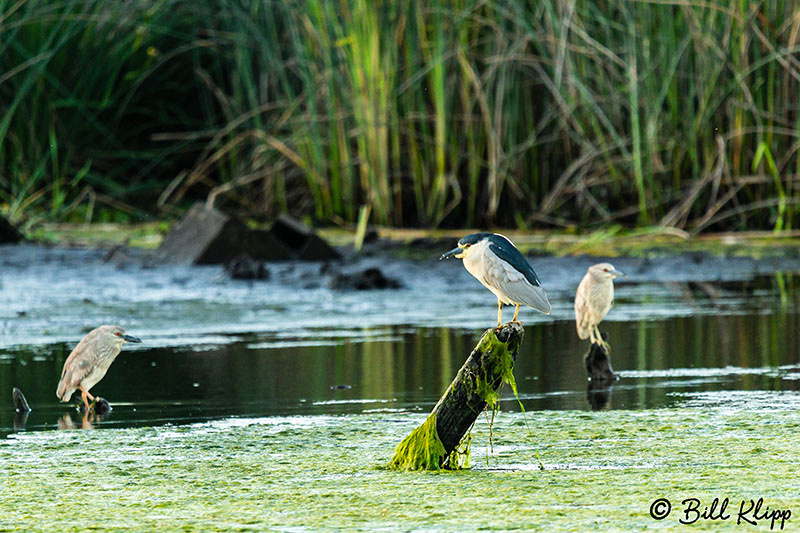 Black Crowned Night Heron, Discovery Bay Photos by Bill KlippBlack Crowned Night Heron, Discovery Bay Photos by Bill Klipp
Black Crowned Night Heron, Discovery Bay Photos by Bill KlippBlack Crowned Night Heron, Discovery Bay Photos by Bill Klipp
All photos © Bill Klipp, not for Commercial Use of any type, for personal use only.
Adult Black-Crowned Night Heron with two juveniles. Compared to their long-limbed Heron relatives Night Heron's are stocky birds who are most active at night or at dusk. They are social birds that breed in colonies of stick nests usually built over water and can be found in fresh, salt, and brackish wetlands and are the most widespread Heron in the world.
 Black Crowned Night Heron, Discovery Bay Photos by Bill KlippBlack Crowned Night Heron, Discovery Bay Photos by Bill Klipp
Black Crowned Night Heron, Discovery Bay Photos by Bill KlippBlack Crowned Night Heron, Discovery Bay Photos by Bill Klipp
All photos © Bill Klipp, not for Commercial Use of any type, for personal use only.
Juvenile Black-Crowned Night Heron
 Black Crowned Night Heron, Discovery Bay Photos by Bill KlippBlack Crowned Night Heron, Discovery Bay Photos by Bill Klipp
Black Crowned Night Heron, Discovery Bay Photos by Bill KlippBlack Crowned Night Heron, Discovery Bay Photos by Bill Klipp
All photos © Bill Klipp, not for Commercial Use of any type, for personal use only.
Juvenile Black-Crowned Night Herons
 Discovery Bay Photos by Bill KlippDiscovery Bay Photos by Bill Klipp
Discovery Bay Photos by Bill KlippDiscovery Bay Photos by Bill Klipp
All photos © Bill Klipp, not for Commercial Use of any type, for personal use only.
This Brewers Blackbird was walking across the algae scum plucking the little weed flowers.
 Great Egrets, Discovery Bay Photos by Bill KlippGreat Egrets, Discovery Bay Photos by Bill Klipp
Great Egrets, Discovery Bay Photos by Bill KlippGreat Egrets, Discovery Bay Photos by Bill Klipp
All photos © Bill Klipp, not for Commercial Use of any type, for personal use only.
Great Egret taking flight
 Great Egrets, Discovery Bay Photos by Bill KlippGreat Egrets, Discovery Bay Photos by Bill Klipp
Great Egrets, Discovery Bay Photos by Bill KlippGreat Egrets, Discovery Bay Photos by Bill Klipp
All photos © Bill Klipp, not for Commercial Use of any type, for personal use only.
Great Egret in flight
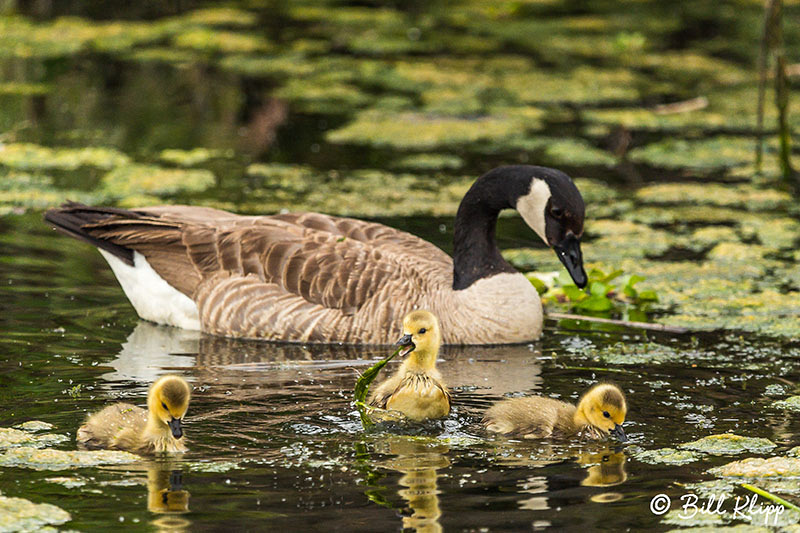 Canada Geese, Discovery Bay Photos by Bill KlippCanada Geese, Discovery Bay Photos by Bill Klipp
Canada Geese, Discovery Bay Photos by Bill KlippCanada Geese, Discovery Bay Photos by Bill Klipp
All photos © Bill Klipp, not for Commercial Use of any type, for personal use only.
Canada Goose with Goslings (previously known as Canadian Geese)
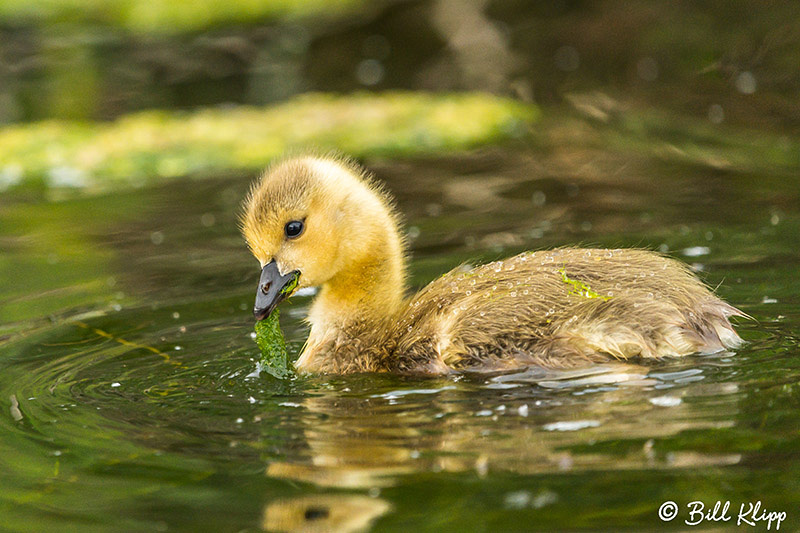 Canada Geese, Discovery Bay Photos by Bill KlippCanada Geese, Discovery Bay Photos by Bill Klipp
Canada Geese, Discovery Bay Photos by Bill KlippCanada Geese, Discovery Bay Photos by Bill Klipp
All photos © Bill Klipp, not for Commercial Use of any type, for personal use only.
Canada Gosling
 Canada Geese, Discovery Bay Photos by Bill KlippCanada Geese, Discovery Bay Photos by Bill Klipp
Canada Geese, Discovery Bay Photos by Bill KlippCanada Geese, Discovery Bay Photos by Bill Klipp
All photos © Bill Klipp, not for Commercial Use of any type, for personal use only.
Canada Goose with some adolescents
 Canada Geese, Discovery Bay Photos by Bill KlippCanada Geese, Discovery Bay Photos by Bill Klipp
Canada Geese, Discovery Bay Photos by Bill KlippCanada Geese, Discovery Bay Photos by Bill Klipp
All photos © Bill Klipp, not for Commercial Use of any type, for personal use only.
 Discovery Bay Photos by Bill KlippDiscovery Bay Photos by Bill Klipp
Discovery Bay Photos by Bill KlippDiscovery Bay Photos by Bill Klipp
All photos © Bill Klipp, not for Commercial Use of any type, for personal use only.
This year's invasive weed season looks like we took a giant step backwards. I have never seen such blockages at the entrance to Discovery Bay
 Discovery Bay Photos by Bill KlippDiscovery Bay Photos by Bill Klipp
Discovery Bay Photos by Bill KlippDiscovery Bay Photos by Bill Klipp
All photos © Bill Klipp, not for Commercial Use of any type, for personal use only.
Tough getting boats off these docks
 Invasive Weed Removal, Discovery Bay Photos by Bill KlippInvasive Weed Removal, Discovery Bay Photos by Bill Klipp
Invasive Weed Removal, Discovery Bay Photos by Bill KlippInvasive Weed Removal, Discovery Bay Photos by Bill Klipp
All photos © Bill Klipp, not for Commercial Use of any type, for personal use only.
Little by little though some enterprising young folks are helping out.
 Discovery Bay Photos by Bill KlippDiscovery Bay Photos by Bill Klipp
Discovery Bay Photos by Bill KlippDiscovery Bay Photos by Bill Klipp
All photos © Bill Klipp, not for Commercial Use of any type, for personal use only.
 Lighthouse, Discovery Bay Photos by Bill KlippLighthouse, Discovery Bay Photos by Bill Klipp
Lighthouse, Discovery Bay Photos by Bill KlippLighthouse, Discovery Bay Photos by Bill Klipp
All photos © Bill Klipp, not for Commercial Use of any type, for personal use only.
The other night it was high tide when we went out so the wildlife was a bit lighter, instead though we had no wind, glassy calm waters, great reflections and some crazy light with ominous clouds
 Discovery Bay Photos by Bill KlippDiscovery Bay Photos by Bill Klipp
Discovery Bay Photos by Bill KlippDiscovery Bay Photos by Bill Klipp
All photos © Bill Klipp, not for Commercial Use of any type, for personal use only.
Windmill farms in the distance
 Discovery Bay Photos by Bill KlippDiscovery Bay Photos by Bill Klipp
Discovery Bay Photos by Bill KlippDiscovery Bay Photos by Bill Klipp
All photos © Bill Klipp, not for Commercial Use of any type, for personal use only.
Indian Slough at the entrance to Lido Bay
 Indian Slough Stormy Weather, Discovery Bay Photos by Bill KlippIndian Slough Stormy Weather, Discovery Bay Photos by Bill Klipp
Indian Slough Stormy Weather, Discovery Bay Photos by Bill KlippIndian Slough Stormy Weather, Discovery Bay Photos by Bill Klipp
All photos © Bill Klipp, not for Commercial Use of any type, for personal use only.
Indian Slough
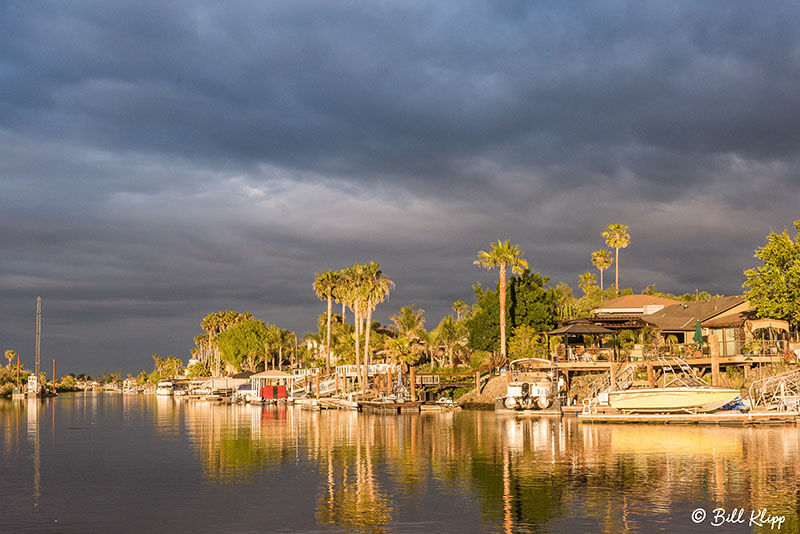 Indian Slough Stormy Weather, Discovery Bay Photos by Bill KlippIndian Slough Stormy Weather, Discovery Bay Photos by Bill Klipp
Indian Slough Stormy Weather, Discovery Bay Photos by Bill KlippIndian Slough Stormy Weather, Discovery Bay Photos by Bill Klipp
All photos © Bill Klipp, not for Commercial Use of any type, for personal use only.
 Indian Slough Stormy Weather, Discovery Bay Photos by Bill KlippIndian Slough Stormy Weather, Discovery Bay Photos by Bill Klipp
Indian Slough Stormy Weather, Discovery Bay Photos by Bill KlippIndian Slough Stormy Weather, Discovery Bay Photos by Bill Klipp
All photos © Bill Klipp, not for Commercial Use of any type, for personal use only.
Lido Bay
 Indian Slough Stormy Weather, Discovery Bay Photos by Bill KlippIndian Slough Stormy Weather, Discovery Bay Photos by Bill Klipp
Indian Slough Stormy Weather, Discovery Bay Photos by Bill KlippIndian Slough Stormy Weather, Discovery Bay Photos by Bill Klipp
All photos © Bill Klipp, not for Commercial Use of any type, for personal use only.
Indian Slough
 Indian Slough Stormy Weather, Discovery Bay Photos by Bill KlippIndian Slough Stormy Weather, Discovery Bay Photos by Bill Klipp
Indian Slough Stormy Weather, Discovery Bay Photos by Bill KlippIndian Slough Stormy Weather, Discovery Bay Photos by Bill Klipp
All photos © Bill Klipp, not for Commercial Use of any type, for personal use only.
 Indian Slough Stormy Weather, Discovery Bay Photos by Bill KlippIndian Slough Stormy Weather, Discovery Bay Photos by Bill Klipp
Indian Slough Stormy Weather, Discovery Bay Photos by Bill KlippIndian Slough Stormy Weather, Discovery Bay Photos by Bill Klipp
All photos © Bill Klipp, not for Commercial Use of any type, for personal use only.
 Discovery Bay Photos by Bill KlippDiscovery Bay Photos by Bill Klipp
Discovery Bay Photos by Bill KlippDiscovery Bay Photos by Bill Klipp
All photos © Bill Klipp, not for Commercial Use of any type, for personal use only.
 Discovery Bay Photos by Bill KlippDiscovery Bay Photos by Bill Klipp
Discovery Bay Photos by Bill KlippDiscovery Bay Photos by Bill Klipp
All photos © Bill Klipp, not for Commercial Use of any type, for personal use only.
A clear sign that summer has arrived, more boat traffic.
 Discovery Bay Photos by Bill KlippDiscovery Bay Photos by Bill Klipp
Discovery Bay Photos by Bill KlippDiscovery Bay Photos by Bill Klipp
All photos © Bill Klipp, not for Commercial Use of any type, for personal use only.
 Discovery Bay Photos by Bill KlippDiscovery Bay Photos by Bill Klipp
Discovery Bay Photos by Bill KlippDiscovery Bay Photos by Bill Klipp
All photos © Bill Klipp, not for Commercial Use of any type, for personal use only.
Coming and Going
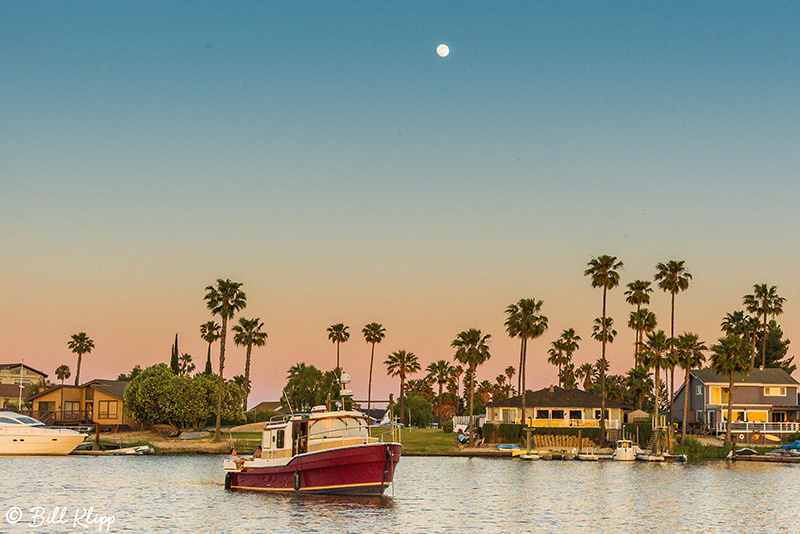 Discovery Bay Photos by Bill KlippDiscovery Bay Photos by Bill Klipp
Discovery Bay Photos by Bill KlippDiscovery Bay Photos by Bill Klipp
All photos © Bill Klipp, not for Commercial Use of any type, for personal use only.
Full Moon over Lido Bay
 Discovery Bay Photos by Bill KlippDiscovery Bay Photos by Bill Klipp
Discovery Bay Photos by Bill KlippDiscovery Bay Photos by Bill Klipp
All photos © Bill Klipp, not for Commercial Use of any type, for personal use only.
Happy Boating, Bye for Now
If you missed my last "Delta Wanderings -- 'Summer's End" blog post check it out at: "Summers End -- 2017"
For more photos visit Bill’s Discovery Bay & Delta website: http://DiscoveryBay.me
© Bill Klipp 2017
Check out my online Photo Website at: http://www.DiscoveryBay.me or http://www.wkimages.net
http://www.videos.wkimages.net / All Rights Reserved Bill Klipp
* Any use of these images requires the prior written permission of Bill Klipp the photographer, no other uses of any kind including print or electronic are permitted without the prior written permission of the photographer.
